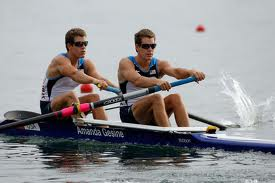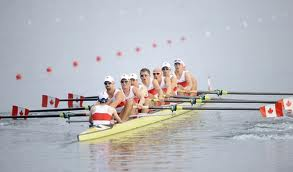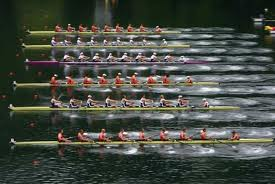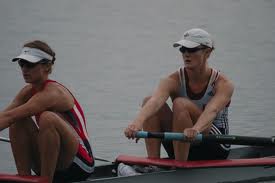
What does Rowing feel like?
| Home | History | Boats & Equipment | Techincal Aspects | Contact |



The whole body is involved in moving a rowing shell through the water. Although rowing looks like an upper-body sport, strong legs are really important. There are four parts of the rowing stroke: Catch, Drive, Release, Recovery, and they all flow together in a smooth, continuous, powerful movement. The motion is so fluid, so smooth, and so seemingly effortless that the agony on the athlete’s faces near the end seems out of place. The last 500 meters of the race are excruciating. The energy is gone, the muscles are burning. And body is well into oxygen debt. But the mental discipline remains, and the athletes continue, straining to synchronize each motion and mentally counting the strokes to the finish. Rowers also bear the pressure of knowing that each stroke they take affects their team-mates and a weak link dooms the crew’s efforts.
The catch: The catch is often referred to as the entry of the blade into the water which should be done quickly and as a continuation of the recovery. It should be well synchronized with the speed of the boat, without to much back splash or front splash. Use the gravity of the weight of the blade, instead of power , to place the oar in the water.
The Drive: While executing the drive, the blade should remain buried in the water, moving horizontally and at even depth of approximately three to four inches. In order to maintain steady pressure the drive should gradually accelerate from the entry to the final push of the boat, to stay with the acceleration of the boat itself. Shoulders swing until the blade leaves the water.
The Release: the release of the blade from the water should follow the last push of the drive. The release should be a quick, clean, fluid motion of the blade up and out of the water while still square. The feather- turning the oar so the blades are parallel to the water’s surface – follows sequentially after the blade leaves the water. The whole path of the blade should be very horizontal during the drive, as well as during the recovery.
The Recovery: During the recovery, the blade travels toward the bow in smooth, horizontal plane at a steady height. There should be enough clearance to allow an easy squaring of the blade before the entry without skimming the surface of the water.
 The Strategy in Rowing
The Strategy in RowingContinuous Motion : Rowing should be continuous, fluid motion and Rowers strive for the perfect synchronization. Clean catches of the Oar blade is strategic because a lot of splash means the oars are not entering the water correctly. The catch should occur at the very end of the recovery when the hands are as far ahead of the rower as possible. Oar blade coordination is a critical strategy where as the blades are brought out of the water, they should move horizontally at the same height, just above the water. Shells move slowest at the catch, quickest at the release and so Consistent speed is another strategy a good crew uses to maintain the speed of the shell or boat. Strokes per Minute are stroke rates that vary from boat to boat, depending on the number of rowers, age, and size of the athletes. At the start , the stroke rate will be higher, 36-44 strokes per minute for an eight. The rate will settle down at the middle of a race to 30-36 for an eight. Finishing stroke rate can go into the high 40's for Olympic rowers. These are all strategies a crew or rowers in a boat may use when racing at a regatta in the pursuit of victory and a gold medal.
 What does Rowing Feel like?
What does Rowing Feel like?
You should use the legs to accelerate the hull and push as much pressure as possible against the water by the time the legs are locking out. The oar is usually around the orthogonal 90 degrees position or thereabouts. Then use the arms to pull on the handle fast enough to put a quick but definite bend in the blade (that is what if feels like to the rower and the coach can see this or capture the image on video). As soon as the oar had been bent, let go of the water, The bending action can be felt in the fingers and becomes a kinesthetic cue for the rower to start the release. Most coaches use the bending of the oar as a coaching tool. There should be no Jerk to the stroke if the timing of the arm pull is correct and it is a technical task that can focus the rower on a discrete and very import part of the drive phase. Rythem is the most important aspect of all which is the ability of a rower to impart a strong and regular rhythm to the hull with his or her crewmates. Of course, setting a rhythm can depend on how well one executes the articulation of the stroke.
